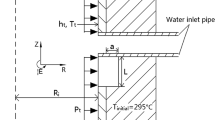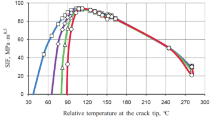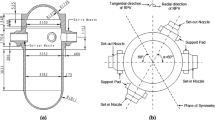Abstract
Pressurized thermal shock (PTS) can subject a crack surface to a very high tensile stress. Also the material toughness is obviously decreased in the cooling process, so it is necessary to study the influence of PTS on the ultimate bearing capacity of a reactor pressure vessel with defects. A 3-D finite element model is established for the beltline region around an inner crack. The FEM is used to reveal the transient temperature field and stress field, and the XFEM is adopted to simulate the ductile crack propagation. To ensure that the strength requirement is satisfied, the ultimate internal pressures of vessels with different crack sizes and different wall thicknesses are obtained. The result shows that the ultimate bearing capacity of the base wall with shallow surface cracks at high temperature is mainly controlled by tensile strength, while it is also affected by the fracture toughness of the material under the severe PTS. The stress in the early stage of the PTS is mainly the thermal stress, and later is the thermo-mechanical coupling stress. The impact of the crack depth on the bearing capacity of the structure is much greater than that of the crack length.














Similar content being viewed by others
References
R. Kempf, H. Troiani, A.M. Fortis, Effect of lead factors on the embrittlement of RPV SA-508 cl 3 steel. J. Nucl. Mater. 434, 411–416 (2013)
B. Marini, X. Averty, P. Wident, Effect of the bainitic and martensitic microstructures on the hardening and embrittlement under neutron irradiation of a reactor pressure vessel steel. J. Nucl. Mater. 465, 20–27 (2015)
M. Chen, F. Lu, R. Wang et al., The deterministic structural integrity assessment of reactor pressure vessels under pressurized thermal shock loading. Nucl. Eng. Des. 288, 130–140 (2015)
M.J. Jhung, Y.H. Choi, Critical crack depth diagram of reactor vessel for pressurized thermal shock. Nucl. Eng. Des. 239(3), 425–433 (2009)
C.E. Pugh, B. Richard Bass, T.L. Dickson, Role of probabilistic analysis in integrity assessment of reactor pressure vessels exposed to pressurized thermal-shock conditions. Eng. Fail. Anal. 14, 501–517 (2007)
G. Qian, M. Niffenegger, Procedure, method and computer codes for probabilistic assessment of reactor pressure vessels subjected to pressurized thermal shocks. Nucl. Eng. Des. 258, 35–50 (2013)
ASME, ASME Boiler and Pressure Vessel Code, Section XI, Appendix A 4000: Material Properties (New York, 2013)
French Association for Design Construction and In-Service Inspection Rules for Nuclear Island Components. RCC-M Code 2000 Edition (Plus 2002 Addendum) (Paris, 2002)
N. Moës, T. Belytschko, Extended finite element method for cohesive crack growth. Eng. Fract. Mech. 69(7), 813–833 (2002)
N. Moës, J. Dolbow, T. BelytsChko, A finite element method for crack growth without remeshing. Int. J. Numer. Meth. Eng. 46(1), 131–150 (1999)
M.L. Benzeggagh, M. Kenane, Measurement of mixed-mode delamination fracture toughness of unidirectional glass/epoxy composites with mixed-mode bending apparatus. Compos. Sci. Technol. 56(4), 439–449 (1996)
Abaqus Users Manual, 2013. Version 6.13-2. Dassault Systemes Simulia Corporation, Providence, Rhode Island, USA
I.P. Pasqualino, S.F. Estefen, A nonlinear analysis of the buckle propagation problem in deepwater pipelines. Int. J. Solids Struct. 38(46–47), 8481–8502 (2001)
M.M. Kashani, L.N. Lowes, A.J. Crewe, Nonlinear fibre element modelling of RC bridge piers considering inelastic buckling of reinforcement. Eng. Struct. 116, 163–177 (2016)
B. Tanguy, J. Besson, R. Piques et al., Ductile to brittle transition of an A508 steel characterized by Charpy impact test. Eng. Fract. Mech. 72(1), 49–72 (2005)
W. Karlsen, G. Diego, B. Devrient, Localized deformation as a key precursor to initiation of intergranular stress corrosion cracking of austenitic stainless steels employed in nuclear power plants. J. Nucl. Mater. 406(1), 138–151 (2010)
International Atomic Energy Agency, Pressurized Thermal Shock in Nuclear Power Plants: Good Practices for Assessments: TECDOC-1627 (IAEA, Austria, 2010)
Nuclear Regulatory Commission, Code of Federal Regulations, Title 10, Section 50.61: Fracture Toughness Requirements for Protection Against Pressurized Thermal Shock Events (NRC, USA, 1984)
Nuclear Regulatory Commission, Radiation embrittlement of reactor vessel materials: Regulatory Guide, No. 1.99, Revision 2 (NRC, USA, 1988)
D.R. Stephens, B.N. Leis, Development of an alternative criterion for residual strength of corrosion defects in moderate to high toughness pipe (American Society of Mechanical Engineers, Canada, 2002)
T.L. Dickson, J.A. Keeney, J.W. Bryson, Validation of a linear-elastic fracture methodology for postulated flaws embedded in the wall of a nuclear reactor pressure vessel, in Proceedings of ASME Pressure Vessel and Pipings, PVP, vol. 403 (Seattle, 2000)
B.R. Bass, C.E. Pugh, J. Sievers et al., Overview of the international comparative assessment study of pressurized thermal-shock in reactor pressure vessels (RPV PTS ICAS). Int. J. Press. Vessels Pip. 78(2–3), 197–211 (2001)
G. Qian, M. Niffenegger, Integrity analysis of a reactor pressure vessel subjected to pressurized thermal shocks by considering constraint effect. Eng. Fract. Mech. 112–113, 14–25 (2013)
Acknowledgements
This study was funded by National Natural Science Foundation of China. Author Guozhong Chai has received research grants from National Science Foundation Committee (Grant Number 51275471). Author Yumei Bao has received research grants from National Science Foundation Committee (Grant Number 51105339). The authors declare that they have no conflict of interest. Furthermore, the authors are grateful for the technical support of the Key Laboratory of Special Purpose Equipment and Advanced Processing Technology of Ministry of Education.
Author information
Authors and Affiliations
Corresponding author
Rights and permissions
About this article
Cite this article
Sun, X., Chai, G. & Bao, Y. Ultimate Bearing Capacity Analysis and Sizing Optimization of a Cracked Reactor Pressure Vessel in the Coupled Thermo-Mechanical Field. J Fail. Anal. and Preven. 17, 680–689 (2017). https://doi.org/10.1007/s11668-017-0290-7
Received:
Revised:
Published:
Issue Date:
DOI: https://doi.org/10.1007/s11668-017-0290-7




